Marine Corps General: The Papers of Ronald Reginald Van Stockum
By Michael R. Veach
Special Collections Assistant
About |
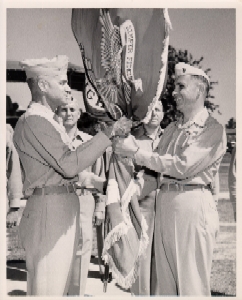 Ronald Reginald Van Stockum grew up on the west coast in Washington state and graduated from the University of Washington ROTC program in 1937. From there he traveled east to the Officers School at the Marine Barracks at the Naval Yards in Philadelphia. The collection has most of his course work from this school. After graduation he was assigned duty on the battleship USS Tennessee. He joined the ship in San Diego and returned east with the ship through the Panama Canal. He was aboard the ship when she sailed into New York harbor during the 1939 World’s Fair.
Ronald Reginald Van Stockum grew up on the west coast in Washington state and graduated from the University of Washington ROTC program in 1937. From there he traveled east to the Officers School at the Marine Barracks at the Naval Yards in Philadelphia. The collection has most of his course work from this school. After graduation he was assigned duty on the battleship USS Tennessee. He joined the ship in San Diego and returned east with the ship through the Panama Canal. He was aboard the ship when she sailed into New York harbor during the 1939 World’s Fair.
His next assignment was on the aircraft carrier USS
Wasp. He was promoted to captain in charge of the Marines on board the Wasp. The carrier sailed the north Atlantic Ocean in the dangerous time before the United States entered World War II and patrolled the seas looking for submarines. He was aboard the Wasp when Pearl Harbor was attacked. The collection includes a copy of the radio transmission sent to the Wasp announcing the attack. The carrier stayed in the Atlantic Ocean when America entered the war and delivered 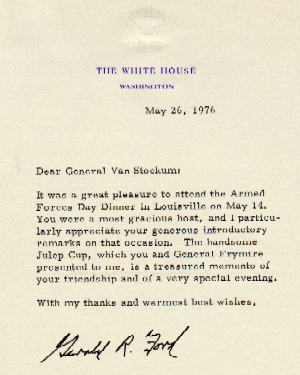 Spitfire fighters to the island of Malta for the British. The delivery was soon destroyed, and the Wasp returned within weeks with a second flight of Spitfires. Van Stockum’s journals from this period, which include descriptions of these activities, are part of this collection. The journals also include an autographed photograph of Douglas Fairbanks Jr., who was an officer on the Wasp at this time. Fairbanks helped Van Stockum get a copy of the congratulatory telegram sent from Winston Churchill to the captain after the second Malta trip in which Churchill stated that this particular Wasp could sting twice.
Spitfire fighters to the island of Malta for the British. The delivery was soon destroyed, and the Wasp returned within weeks with a second flight of Spitfires. Van Stockum’s journals from this period, which include descriptions of these activities, are part of this collection. The journals also include an autographed photograph of Douglas Fairbanks Jr., who was an officer on the Wasp at this time. Fairbanks helped Van Stockum get a copy of the congratulatory telegram sent from Winston Churchill to the captain after the second Malta trip in which Churchill stated that this particular Wasp could sting twice.
Van Stockum left the Wasp when it was transferred to the Pacific Ocean. He trained in New Zealand for amphibious warfare and was then involved in invasions of Bougainville, Guam and Iwo Jima. By the end of the war he had been promoted to Colonel and received several medals, including the Bronze Star. The collection is a bit sparse during this point of his career. Due to security reasons he could not keep a journal nor write detailed letters. Even so, valuable information still exists through maps of Iwo Jima beaches and other official papers.
After the war Colonel Van Stockum returned to the States and became involved in training and recruiting.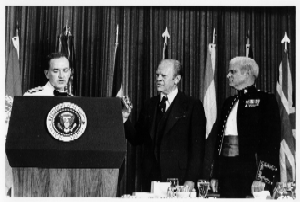 Photographs and journals from the collection document his involvement in a training exercise at Thule, Greenland in 1951. Following his time in Greenland, he then spent several years in Japan where he made many motor trips exploring the countryside. His journals describe these trips and the primitive road conditions found in Japan in the early 1950s in addition to his interaction with the Japanese people. One road trip found him and his wife stranded in the Japanese countryside when their automobile slipped into a rut and damaged the oil pan. A kindly road crew helped them by making temporary repairs to the vehicle.
Photographs and journals from the collection document his involvement in a training exercise at Thule, Greenland in 1951. Following his time in Greenland, he then spent several years in Japan where he made many motor trips exploring the countryside. His journals describe these trips and the primitive road conditions found in Japan in the early 1950s in addition to his interaction with the Japanese people. One road trip found him and his wife stranded in the Japanese countryside when their automobile slipped into a rut and damaged the oil pan. A kindly road crew helped them by making temporary repairs to the vehicle.
After leaving Japan, Van Stockum returned to the United States. He
attended the Army’s Arctic Training School in Alaska and then became the first Marine officer to attend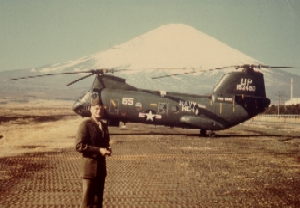 the Canadian Defense College. During this training he visited Canadian, American and European defense sights and witnessed the launching of the United States’ first satellite, “Explorer I,” while at Cape Canaveral. At the Canadian Defense College, Van Stockum met British diplomat John Killick. Killick later wrote to Van Stockum on May 3, 1960 discussing the growing tensions in Europe. Killick advised him not to make vacation plans unless they included a cruise on an aircraft carrier. Killick felt he was too low of a diplomat do anything about the tensions but too high not to know what was happening.
the Canadian Defense College. During this training he visited Canadian, American and European defense sights and witnessed the launching of the United States’ first satellite, “Explorer I,” while at Cape Canaveral. At the Canadian Defense College, Van Stockum met British diplomat John Killick. Killick later wrote to Van Stockum on May 3, 1960 discussing the growing tensions in Europe. Killick advised him not to make vacation plans unless they included a cruise on an aircraft carrier. Killick felt he was too low of a diplomat do anything about the tensions but too high not to know what was happening.
His next assignment led him to Camp Lejeune, N.C. While at Camp
Lejeune, Van Stockum was again involved in amphibious training exercises and played the role of 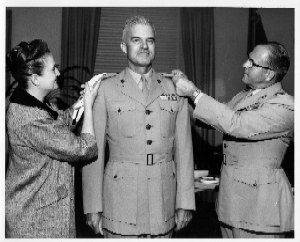 “Colonel-General” of the “Aggressor Army” in some war games. In a newspaper article about these war games, Van Stockum describes his role as an aggressor and how he enjoyed playing the role of the “Colonel-General.” The collection contains many photographs taken during these exercises. He later found himself as chief of staff of the base. His stay at Camp Lejeune ended when he was promoted to brigadier general.
“Colonel-General” of the “Aggressor Army” in some war games. In a newspaper article about these war games, Van Stockum describes his role as an aggressor and how he enjoyed playing the role of the “Colonel-General.” The collection contains many photographs taken during these exercises. He later found himself as chief of staff of the base. His stay at Camp Lejeune ended when he was promoted to brigadier general.
His promotion placed him in charge of Marine Corps Reserves units in the Pennsylvania and Ohio area. He made many trips inspecting these units and meeting their commanders. He was in Washington, D.C. when John Glenn was honored with a parade review after returning from orbiting the Earth. Photographs and programs from the parade show that Van Stockum was one of the reviewing officers for the parade.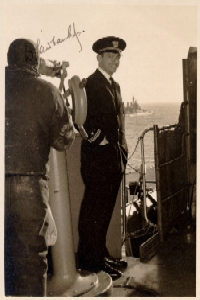
In 1966 General Van Stockum received orders to go to Okinawa. At that time the island was becoming an important staging area for the war in Viet Nam. General Van Stockum was involved in organizing the logistics of moving people and supplies to and from Viet Nam. He made several trips to other sites in the region including trips to Japan, Korea, Taiwan and Viet Nam. Correspondence from this time includes letters from many other flag officers from all branches of the military serving in the area. He returned to the United States in 1967.
General Van Stockum served as the Marine Corps Representative on the Navy Department Board of Decorations and Medals until his retirement in 1969. The collection has several records from cases he reviewed and correspondence discussing the issue of “award inflation.” Many people on the board felt that too many medals and citations were being handed out, thus lessening the value of the award given to those who earned them by the older, tougher standards.
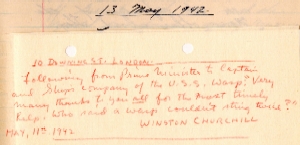 After retirement from the Marine Corps, General Van Stockum moved to Shelbyville, Ky., and worked for the University of Louisville. He did not leave the military life behind completely. He remained active by serving on the Louisville Armed Forces Commission and was here when President Gerald Ford came to speak in the city. He was active in other fields as well. He served a term as president of The Filson Historical Society and as interim director for about a year. By the early 1990s Van Stockum had retired to his farm in Shelbyville where he and his sons organized
After retirement from the Marine Corps, General Van Stockum moved to Shelbyville, Ky., and worked for the University of Louisville. He did not leave the military life behind completely. He remained active by serving on the Louisville Armed Forces Commission and was here when President Gerald Ford came to speak in the city. He was active in other fields as well. He served a term as president of The Filson Historical Society and as interim director for about a year. By the early 1990s Van Stockum had retired to his farm in Shelbyville where he and his sons organized 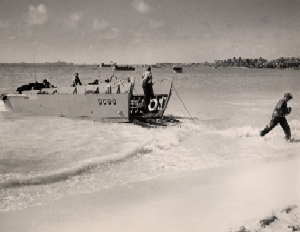 his papers to be donated to The Filson.
his papers to be donated to The Filson.
This collection is a valuable resource for anybody researching the Marine Corps in the 20th century. General Van Stockum served a variety of roles from combat to administration, so all aspects of Marine life are covered in the collection. It is also a valuable resource for those interested in the Cold War. Many of his letters to fellow officers and foreign counterparts discuss Cold War issues and policies. The list of correspondents in the collection includes officers from all branches of the military and many foreign military officials. His travel journals in Japan are valuable for anyone looking into the physical and political re-construction of Japan after World War II. The papers of General Van Stockum are an excellent 20th-century extension of The Filson’s military collections of the 19th century.
The Filson Historical Society
1310 South Third Street - Louisville, KY
40208
Phone: (502) 635-5083 Fax: (502) 635-5086
Hours
The Ferguson Mansion and Office
Monday - Friday: 9 am. - 5 pm.
Saturday and Sunday closed
Library
Monday - Friday: 9 am. - 5 pm.
Saturday: 9 am. - 12 noon
